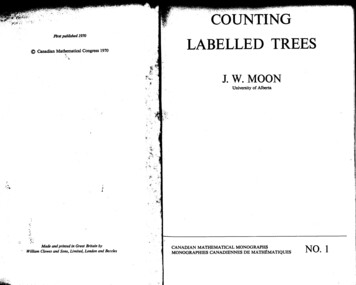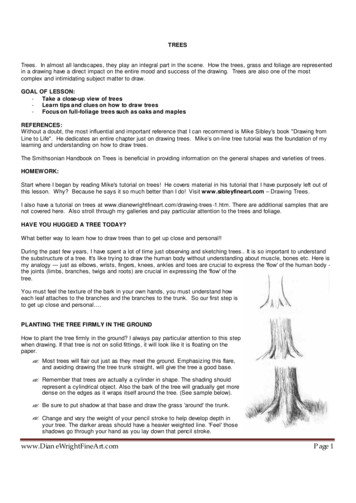
Transcription
'COUNTINGLABELLED TREESJ. W. MOONMade and printed in Great Britain byWilliam Clowes and Sons, Limited, London and BecclesCANADIAN MATHEMATICAL MONOGRAPHSMONOGRAPHIES CANADIENNES DE MATHEMATIQUESNO.1
La publication de la conference de John Moon, Counting LabelledTrees, est un autre jalon de l'histoire de la Societe Mathematique duCanada. Nous esperons que cette monographie sera la premiere d'unelongue serie.Du point de vue historique, les premieres publications de la Societe ontete limitees aux comptes rendus des Congres et peu apres au JournalCanadien de Mathematiques. Dans les premiers temps, la publication duJournal Canadien etait une entreprise d'envergure et avait tendance aprendre Ie pas sur les autres efforts de publication. Avec l'avenement duBulletin Canadien de Mathematiques, les autres publications ont ete pourainsi dire negligees. Ce fait est a deplorer si l'on considere la haute valeurd'un grand nombre des conferences de nos seminaires. Plusieurs de cesconferences furent publiees sous forme de notes polycopiees qui, en plus den'etre pas tres attrayantes, n'etaient a la disposition que d'un petit nombre.De fait, elles auraient merite une meilleure diffusion - realisable si ces notesavaient paru sous forme de livre.La societe se considere privilegiee de pouvoir commencer cette serie avecune oeuvre de John Moon. Avec la competence qui Ie caracterise il a sureunir les elements d'un sujet interessant et de lecture tres agreable.En tant que president de la Societe Mathematique du Canada, je desireoffrir mes felicitations au professeur Moon qui lance cette serie et etablitainsi un haut degre d'excellence que ses successeurs voudront atteindre.N. S. MendelsohnThe publication of John Moon's Counting Labelled Trees marks yetanother milestone in the history of the Canadian Mathematical Congress.It is hoped that this monograph will be the first of a continuing series.Historically, the early publications of Congress were confined to theProceedings of Congresses and shortly after that the Canadian Journal ofMathematics. In those first days the publication of the Canadian Journalwas a large undertaking and tended to push into the background otherefforts of publication. With the coming of the Canadian MathematicalBulletin, other publications were virtually neglected. In retrospect, this is agreat pity since such activities as our biennial seminars contained a largenumber of magnificent lecture series. Many of these appeared as mimeographed lecture notes which, besides their unattractive appearance, wereavailable only to a few. In fact, they deserved widespread circulation andthis would have been achieved if the notes had been edited and publishedin book form.Congress is very fortunate in having the first book of this series writtenby John Moon. With impeccable scholarship, he has put together theresults of an attractive subject in a highly readable form.As president of the Canadian Mathematical Congress, I wish to congratulate Professor Moon for launching the series and setting a highstandard for others to follow.
My object has been to gather together various combinatorial resultson labelled trees. The basic definitions are given in the first chapter;enumerative results are presented in the next five chapters, classifiedaccording to the type of argument involved; some probabilistic problemson random trees are treated in the last chapter. Some familiarity withmatrices and generating functions is presupposed, in places, but much ofthe exposition should be accessible to anyone who knows something aboutfinite mathematics or probability theory.This material was originally prepared for a series of lectures I gave at theTwelfth Biennial Seminar of the Canadian Mathematical Congress at theUniversity of British Columbia in August, 1969. I am indebted to Professors Ronald Pyke and John J. McNamee for their invitation andencouragement.Edmonton, AlbertaFebruary, 1970
1. Introduction1.1 Definitions1.21.3PropertiesSummaryof TreesAssociating Sequences with Trees2.1 Priifer Sequences2.2 Tree Functions2.3 Knuth's Generalization of PrUfer Sequences2.4 Special Cases,3. Inductive Arguments3.1 Some Identities3.23.33.4. 3.53.63.73.83.9Trees with a Given Degree SequenceTrees in which the Degree of a Given Node is SpecifiedThe Number of k- TreesForests of Trees with Specified RootsConnected Graphs with One CycleTrees with a Given Number of EndnodesRecurrence Relations for T(n)Connected Graphs with.Unlabelled Endnodes4. Applications of4.1 Counting4.2 Counting4.3 CountingGenerating FunctionsConnected GraphsRooted Trees and ForestsUnrooted Trees and Forests
4.4 Bipartite Trees and Forests4.5 Counting Trees by Number of Inversions4.6 Connected Graphs with Given Blocks3032335. The5.15.25.35.45.55.65.7Matrix Tree TheoremIntroductionThe Incidence Matrix of a GraphThe Matrix Tree TheoremApplicationsThe Matrix Tree Theorem for Directed GraphsTrees in the Arc-Graph of a Directed GraphListing the Trees in a Graph393941434648516. The6.16.26.36.46.56.6Method of Inclusion and ExclusionIntroductionThe Number of Trees Spanned by a Given ForestThe Number of Spanning Trees of a GraphExamplesTrees Containing a Given Number of Specified EdgesMiscellaneous Results5252545462647. Problems on Random Trees7.1 Random Mapping Functions7.2 The Degrees of the Nodes in Random Trees7.3 The Distance between Nodes in Random Trees7.4 Trees with Given Height and Diameter7.5 The First Two Moments of the Complexity of a Graph7.6 Removing Edges from Random Trees7.7 Climbing Random Trees7.8 Cutting Down Random Trees1667076787983869099Author Index109Subject Index112iI11.1. Definitions. A graph Gn consists of a finite set of n nodes some pairsof which are joined by a single edge; we usually assume the nodes arelabelled 1,2, . , n and that no edge joins a node with itself. A node andan edge are incident if the edge joins the node to another node. Thedegree of a node is the number of edges incident with it; an endnode of agraph is a node of degree one.Suppose the graphs Gn and Hn have the same number of nodes. If nodesi andj of Gn are joined by an edge if and only if nodes i andj of Hn arejoined by an edge, then we say Gn and Hn determine the same labelledgraph; more generally, if Gn and Hn determine the same labelled graph forsome relabelling of their nodes, then we say Gn and Hn are isomorphic orthat they determine the same unlabelled graph. The labelled graphs withthree nodes and the unlabelled graphs with four nodes are shown inFigures 1 and 2.A path is a sequence of edges of the type ab, bc, cd, . , 1m where eachedge ij joins the nodes i and j. We usually assume the nodes a, b, . , 1aredistinct; if a m we call the path a cycle. The length of a path or cycle isthe number of edges it contains; sometimes it is convenient to consider asingle node as a path of length zero. A graph is connected if every pair ofnodes is joined by a path; any graph is the union of its connected components. The distance between two nodes in a connected graph is the lengthof any shortest path joining them.'ii1.2. Properties of Trees. A tree is a connected graph that has no cycles.Konig (1937;pp. 47-48)lists some of the early works in which the conceptof a tree appears; the earliest were by Kirchhoff and von Staudt in 1847.1
2Introduction111 \2 3L2 36231\23/ 3.-\2.23.13.11 3.211.2FIGURE 1- UD- 12]L L bJlL2FIGUREThe trees with up to six nodes and the number of ways of labelling theirnodes are illustrated in Figure 3. The trees with up to ten nodes (and up totwelve nodes in sollie cases) were drawn by Rarary and Prins (1959).oIlYY We shall use the following properties of a tree in what follows (theseproperties and others can be combined to provide at least sixteen equivalent definitions of a tree; see Anderson and Rarary (1967) and Rarary andManvel (1968».LEMMA1.1. If a tree has at least two nodes, then it has at least twoendnodes.This may be proved by considering two nodes joined by one of thelongest paths in the tree.LEMMA1.2. If a tree has n nodes, then it has n - 1 edges.This may be proved by induction on n, using Lemma 1.1.LEMMA1.3. Any two nodes of a tree are joined by a unique path.Any two nodes of a tree must be joined by at least one path because atree is connected; if they were joined by more than one path the tree wouldcontain a cycle and this is impossible by definition.1.3. Summary. Let T(n) denote the number of trees Tn with n labellednodes, for n 1,2, . The formula T(n) nn-2 is usually attributed toCayley (1889). Re pointed out, however, that an equivalent result wasproved earlier by Borchardt (1860); this result appeared without proof inan even earlier paper by Sylvester (1857). The formula for the number oflabelled trees has been rediscovered, conjectured, proved, and generalizedmany times. Our object here is to summarize various results of a combinatorial or probabilistic nature that are known about labelled trees and tosurvey the more important methods that have been used to establish theseresults. For additional material on these and related problems see, forexample, Riordan (1958) and Knuth (1968a).
ASSOCIATINGSEQUENCESwhen n 6 and remarks that " . . it will be at once seen that the proofgiven for this particular case is applicable for any value whatever of n".Priifer (1918), apparently unaware of Cayley's paper, constructs thecorrespondence as follows. From any tree Tn remove the endnode (and itsincident edge) with the smallest label to form a smaller tree Tn-l and let aldenote the (label of the) node that was joined to the removed node;repeat this process on Tn-l to determine a2 and continue until only twonodes, joined by an edge, are left. The tree in Figure 4, for example,determines the sequence (2, 8, 6, 2, 8, 2). Different trees Tn determine7 3S.V I2128 6 4FIGURE 42.1. Priifer Sequences.Some enumeration problems for trees can betreated by associating certain sequences with trees; a useful feature of thistype of argument is that various properties of the trees are reflected in thecorresponding sequences.THEOREM 2.1. if n 3 there is a one-to-one correspondence between thetrees Tn with n labelled nodes and the nn-2 sequences (al a2," ., an-2) thatcan beformedfromthe numbers 1,2, . , n.Cayley would prove this when n 5 by classifying the terms in a certainexpansion as follows (the symbols a, fJ, y, 8, and denote the numbers1,2,3,4,and 5 in some order):3(a fJ y 8 )3afJy8 5}5la 3a2fJ 20 afJy8 60 6afJy6010125The multinomial coefficients 1,3, and 6 show how many times these termsappear, and the numbers 5, 20, and 10 show how many terms like thesecan be formed with the factors a, fJ, y, 8, and . The terms of the typea4fJy8 (afJ)(ay)(a8)(a ) correspond to the trees Ts that have a node a ofdegree four; the terms, a3fJ2y8 correspond to the trees Ts with a node a ofdegree three joined to a node fJ of degree two; the terms a2fJ2y28 correspond to the paths on five nodes with endnodes 8 and .Cayley gives no explicit rule for establishing the correspondence betweentrees and sequences in general. He merely exhibits such a correspondence4different sequences (al a2,""an-2); it remains to show that each suchsequence corresponds to some tree Tn.Suppose (al, a2, . , an-2) is any sequence formed from the numbers1,2, . , n. If bl denotes the smallest positive integer that does not occurin the sequence, let (C2"'" Cn-2) denote the sequence obtained from(a2, . , an-2) by diminishing all terms larger than bl by one. Then(C2"'" Cn-2) is a sequence of length n - 3 formed from the numbers1,2,, n - 1 and we may assume there exists a tree Tn-l with nodes1, 2,, n - 1 that corresponds to this sequence. Relabel the nodes ofTn-l by adding one to each label that is not less than bl; if we introducean nth node labelled bl and join it to the node labelled al in Tn-l we obtaina tree Tn that corresponds to the original sequence (al a2,' . , an-2)' Thisshows that Priifer's construction provides a one-to-one correspondencebetween these sequences and the trees Tn.Neville (1953) gives three methods for defining a sequence correspondingto a tree (see also Knuth (1968a; p. 397». The first is the method just described. The second differs in that if we have just removed a node bl thatwas joined to al we remove al next if al is now an endnode; otherwise weremove the endnode with the smallest label as before. In the third methodall the endnodes of the original tree are removed in the order of the size oftheir labels; then all the endnodes of the remaining tree are removed, andso on. The sequences (al a2,""an-2) are defined in terms of the nodesremoved as before. The tree in Figure 4, for example, determines thesequences (2, 8, 6, 8, 2, 2) and (2, 8, 6, 2, 2, 8) if these last two methods areused. It can be shown by modifications of the argument given earlier thateach sequence (al a2 . , an 2) corresponds to some tree Tn with respect
to these methods. (The last two methods described are not quite the sameas the methods described by Neville; he would never remove the nodelabelled n.)It is not difficult to see that if node i of Tn has degree d;, then the numberi occurs dj - 1 times in the sequence associated with Tn (this is true nomatter which of the three methods for constructing the sequence is used).Since any sequence (ab a2,"" an-2) formed from the numbers 1,2, . , ndetermines a tree Tn it follows that the only restriction on the dj's is thatthey be positive integers and that .L:f 1 (dj - 1) n - 2. Thus the positiveintegers (d1, d2, . , dn) form the degree sequence of some tree Tn if andonly if their sum is 2(n - I). This result apparently first appears in apaper by Senior (1951) as a special case of a more general result (see alsoBabler (1953), Hakimi (1962), Menon (1964), and Ramanujacharyulu(1965)). It also follows from Priifer's construction that the number oftrees Tn with a given degree sequence (db d2, . , dn) is given by themultinomial coefficient(d1This formula, which(1966), can be usedlater. (Zarankiewiczand q nodes whosethese latter q nodesn-2-1, . , dn)-1 .was pointed out by Moon (1964, 1967a) and Riordanto derive a number of other results as we shall see(1946) has pointed out that if a tree has p endnodesdegree exceeds two, then the sum of the degrees ofequals 2(q - I) p.)2.2 Tree Functions.Before describing some extensions of Priifer'smethod we introduce more terminology. Suppose we choose some specificnode of a tree Tn say the nth node, and call it the root. There exists a uniquepath from any other node i to the root; if ij is the first edge in this path letf(i) j. The functionfis called the tree function of Tn. We could representthe functionfbythe directed rooted tree-sometimescalled an arborescence-obtainedfrom Tn by replacing each edge ij by an arc 7j directed from i toj, where j f(i); each node, with the exception of the root, now hasexactly one arc directed away from it. Supposefis any function that maps{I, 2, . , n - I} into {I, 2, . , n}. Glicksman (1963) has shown thatfisa tree function if and only if {f(i): i E A} r;f: A for every non-empty subsetA of {I, 2, . , n - I}. The necessity of this condition follows from thefact that a tree has no cycles; the sufficiency can be proved by constructinga tree that corresponds to f by working backwards inductively from theroot.A. Lempel, E. Palmer, and perhaps others have observed that there arenn- 3 different trees with n unlabelled nodes and n - 1 edges labelled1,2, . , n - 1 when n 3. One way to prove this is as follows. Let fdenote the tree function of a node-labelled tree Tn; assign the label i tothe edge ij, where j f(i), for i 1, 2, . , n - 1. It is not difficult tosee that this defines a mapping of the set of nn- 2 node-labelled trees Tnonto the set of edge-labelled trees and, when n 3, each edge-labelledtree is the image of n node-labelled trees. Palmer (1969) has treated similarproblems for a different type of tree.We qigress a moment to mention the following problem of Riordan's,although perhaps it is not obvious that the problem has anything to dowith trees. There are n parking spaces available along a street and each ofn drivers, arriving consecutively, has a preferred parking space; the ithdriver will park in space g(i) if it is still available when he arrives and if itis not he will park in the next unoccupied space he finds (if there is one).Every driver can find a parking space (without driving around the block)if there exists a permutation 7Tof {I, 2, . ,n} such that 7T(j) is the leastinteger greater than or equaltog(j)that is not in the set {7T(I),. , 7T(j - I)}for 1 :s;j :s; n. Schiitzenberger (1968) showed by induction that there isa one-to-one correspondence between the preference functions g in whicheveryone finds a parking space and the tree functions that map {I, 2, . , n}into {I, 2, . , n I}. Riordan (1969) has given other more direct proofsof the fact that there are (n I)n -1 such functions g.2.3. Knuth's Generalization of Priifer Sequences. A directed graph Dconsists of a collection of nodes some ordered pairs of which are joined bya directed edge, or arc; we say the arc 7j is directed from node i to node j.The graph D may contain both of the arcs 7j andft and it may contain arcsof the typecalled loops.A graph is a spanning subgraph of a second graph if they have the samenodes and every edge (or arc) in the first graph is also in the second. Whenwe refer to a spanning subtree of a directed graph, we shall always mean adirected rooted tree of the type described above in which each arc isdirected towards the root; in particular, if the directed graph is rooted ata particular node x, then the spanning subtree is to be rooted at x.If D is any directed graph with h labelled nodes and (Sb S2, . , Sh) is anycomposition of n into h positive integers, let H denote the graph obtainedby replacing each node i of D by a set Sj of Sj nodes; the arcis in H ifand only if x and y belong to subsets Sj and Sj such that the arc 7j was in D.(Notice that if D had some loops, then H also has loops.) We assume forconvenience that the n nodes are labelled so that if i j then the nodes ofSj have smaller labels than the nodes of Sj' We also assume Sh 1 so Shconsists simply of the nth node; we think of this node as the root of bothD·and H although it is labelled differently in the two graphs.Let r(Sj) denote the set of nodes y in H such that y is the terminal node7ixY
of some arc issuing from a node of SI (notice that SI S; r(SI) if the loopthe tree function of a spanning subtree of G (that is rootedat the hth node of G), letf(SI) Sj if j f(i) for i 1,2, . , h - 1. Weshall let IXI denote the number of elements in the set X.The following result is a special case of a more general result due toKnuth (1968); it expresses the number c(H) of spanning subtrees of H(rooted at node n) in terms of the spanning subtrees of D (rooted at nodeTI is in D). Iffish).L {rr Ir(SI)18 -1'lf(SI)I},h-1c(H) 1f1 1where the sum is over the tree functions f of all spanning sub trees of D.The proof involves showing there is a one-to-one correspondencebetween trees spanning H and the ordered sets of h - 1 sequences of theformwhere a(i,j) is any member of r(SI) for j 1, 2, . , Sl - 1, and a(i, Sl) isany member off(SI), for i 1,2, . ,h - 1, for the tree functionfofsome spanning subtree of D.Suppose the tree T spans the graph H. We successively remove the endnodes with the smallest labels, as before; now, however, when we removean endnode b from a subset SI we write the label of the node joined to b inthe next position of the ith sequence. When only one edge remains, joining some node of Sj, say, to the nth node, we put an n in the last positionof the jth sequence. It is clear that each term a(i,j) belongs to r(SI)' Whenthe last node b of SI is removed, suppose the node joined to b belongs tothe subset Sj. If we let f(i) j, then it is not difficult to show, usingGlicksman's result, that the function f is the tree function of a spanningsubtree of D. Thus, every tree spanning H can be associated with a set ofsequences of the type described above. It can be shown by induction thatthere exists a spanning tree of H corresponding to each such set ofsequences.Knuth's more general result applies when Sh ;;:: 1 and one wants todetermine the number of families of disjoint directed rooted trees thatcollectively span H and whose roots constitute specified subsets of nodesof H; we now describe three corollaries he deduced from his theorem.2.4. Special Cases. Suppose the graph H is obtained from the directedgraph D illustrated in Figure 5. There is only one spanning subtree of D(rooted at the bottom node) and its arcs are ii, 23, and 34. It follows fromTheorem 2.2 that there are S lS 2(Sl 1)83-1 spanning subtrees of H. Ifwe think of the bottom node as a member of Sl, then we can think of H ashaving arisen from a directed 3-cycle and we can abandon the restrictionSh 1. The following more general result can be proved in the same way.COROLLARY2.2.1. If the graph D is a directed h-cycle and h ;;::2, thenthere arespanning sub trees of H that are rooted at any given node of the first subsetof nodes.Theorem 2.2 also applies when the graphs D and H are ordinary undirected graphs since any undirected graph G can be transferredjnto equivalent directed graph D by replacing each edge ij by the arcs ij and ji.The following result, apparently proved first by Rohlickova (1966) byanother method, is the analogue of Corollary 2.2.1 for ordinary undirectedgraphs.COROLLARY2.2.2. If G is a cycle of length h(;;::2), thenc(H) (Sh S2)81-1(Sl SS)82-1 . (Sh-1x «SlS2)-1 Sl)8h-1S1S2'" Sh (S2SS)-1 . (ShS1)-1).To prove this we select some node to serve as a root, treat it as thoughit constituted a separate subset by itself, and apply Theorem 2.2 as before;the details of the derivation are somewhat more complicated than theywere in the proof of Corollary 2.2.1, however, because the root-node isjoined to nodes from two other subsets of nodes of H and there are morespanning subtrees to consider.If the (undirected) graph G is a tree with h nodes, there is only onespanning subtree of G, namely G itself. There is no loss of generality ifwe assume the hth node is an endnode. If we ignore the restriction Sh 1and treat some node in the hth subset of nodes of H as a root-node constituting a separate subset by itself, we find that the formula in Theorem
2.2 can be rewritten as follows. (The result still holds even if G has someloops if they are ignored in determining the degree sequence.)COROLLARY2.2.3. If G is a tree with degree sequence (d1 d2, . , dh),thenhc(H) Il!r(Sj)!St-1stt-1.rooted trees that can be formed on the nodes of A subject to the followingconditions: (1) each tree T in the forest F contains just one node of Bandthis node is the root of T; (2) each node of A is assigned one of t coloursand there are Cj nodes of the ith colour; and (3) each edge in a tree T of Fis given the same colour as the node with which it is incident that is nearestthe root of T and there are ej edges of the ith colour in F.j lCOROLLARYAn r by s bipartite graph is a graph with r "dark" nodes and s "light"nodes such that every edge of the graph joins a dark node with a light node.If we let G be the graph consisting of a single edge joining two nodes, thenit follows from Corollary 2.2.3 (or 2.2.1) that there are rs-1s 1bipartitetrees with r labelled dark nodes and s labelled light nodes. This particularresult was apparently first proved by Fiedler and Sedlacek (1958); we shalldiscuss their derivation and others later. If (r1 . , r and (S1 . , ss) arecompositions of r s - 1 into positive integers, then it follows from theproof of Theorem 2.2 that there areT-T)(r1s-l1, . ,rT--)(1 .r-lSl-2.2.4.T( n, k ; c, e) k(-n)(n-k)en C1 . ,Ct e1 . ,etC11 eCtl Let G denote the graph on three nodes in which the second node isjoined to the first and third nodes; the first node is also joined to itself bya loop. Let H be the graph defined earlier with h 3 and (Sl, S2, S3) (n - k, k, 1); we consider the nodes of S2 as the nodes of B and the nodesof 81as the remaining nodes of A. It follows from the proof of Theorem2.2 that each spanning subtree of H corresponds to a pair of sequences)1, . ,ss - 1where a ES1US2for i 1,2, . ,n-k-l,(In-kES2,b ES1U I} for i 1,2, . , k - 1, and bk n 1. It is not difficult to seethat forests F on the nodes of A Sl U S2 consisting of k disjoint rootedtrees each of which is rooted at a node of B S2 correspond to spanningsubtrees of H in which the (fictitious) (n l)st node is joined to everynode of B; such subtrees correspond to the sequences in which b n 1for i 1,2, . , k. It remains to enumerate the sequences (a1 a2, . , an-k)corresponding to forests F satisfying conditions (2) and (3) also.jbipartite trees for which the degree sequences of the r dark nodes and thes light nodes are (r1 . , r and (Sl, . , ss). This formula can be used toderive the following results of Klee and Witzgall (1967); if s ru 1 thenthere are (ru 1)'-l(ru)!j(u!)' r by s trees in which the r dark nodes allhave degree u 1; if s ru - 1 then there are r 2(ur - 1)!j«u - I)!)'r by s trees in which u - 1 of the nodes joined to each dark node areendnodes.Every tree Tn corresponds to two r by s bipartite trees, for some valuesof rand s (if we think of the nth node as belonging to one of the two nodesets then the ith node will belong to the same node set or the other nodeset according as the distance between i and n in Tn is even or odd). Itfollows from this observation thatT)T-L:j{njThere are (n) ways to colour the nodes of A and satisfy conC1 '. , Ctdition (2). Once this has been done, there must be ej positions in thesequence (aI, a2, . , an k) in which the label of one of the Cj nodes ofcolour i appears. These positions can be chosen and filled inn( )kn-k-1(n- k)k-1 2nn-2;k Othis is a special case of the second identity listed later in Table 1 andAustin (1960) has derived a multinomial extension of this identity.The proof of Theorem 2.2 also yields a solution to a problem consideredby Raney (1964) in the course of deriving a formal power series solutionto the equation 2:i 1 Aj exp (BjX) X. Let B denote some subset of knodes of a subset A of n labelled nodes; let C (C1 . , Ct) and e (e1 . , et) denote compositions of nand n - k into t non-negativeintegers. Let T(n, k; c, e) denote the number of forests F of k disjointways. Of all the possible sequences thus constructed only the fraction kjnhave the additional property that an-k E S2 B and thus correspond tosuitable forests F. This completes the proof of the corollary. If t 1, thenthe above formula reduces to knn - k -1; this particular result was alsostated by Cayley and, implicitly, by Borchardt.
3.2. Trees with a Given Degree Sequence. We saw earlier that formula(2.1) for the number T(n; dl d2, . , dn) of trees Tn whose degree sequenceis (dl d2, . , dn) could be deduced from Priifer's argument. The followingderivation, given by Moon (1967b), is based on the fact that the multinomial coefficients satisfy the recurrence relationwhere the sum is over all i such that aj ;:: 1.THEOREM3.1.If n ;:: 3, thenT(n; dl d2, . , dn) (d In-2 d - I) .1, , n33.1. Some Identities.Various formulas for the number of trees enjoying certain properties can be established by induction; such argumentsusually require a knowledge of an appropriateidentity or recurrencerelation.Riordan (1968, Section 1.5) has given an elementary derivation of anUlllber of identities involving Abel sums of the typenAn(x, y;p, q) L( )(x k)k P(y n-k)n-k q.k OIn what follows we shall make use of some special cases of the identitieslisted in the following table.We may suppose that (dl d2,, dn) is a composition of 2(n - I) intopositive integers since T(n; dl, d2,, dn) 0 otherwise. It will simplifythe notation later if we assume that dn I (this is no real loss of generalitysince some nodes must be joined to only one other node). We now showthat(3.2)T(n;dl,d2,. ,dn) LT(n- I;dl . ,dj - I, . ,dn-l),where the sum is over all i such that dj ;:: 2.Consider any tree Tn with degree sequence (dl, d2, . , dn) where thenth node is joined only to one other node, say the ith; it must be thatdj ;:: 2 if n ;:: 3 since the tree is connected. If the nth node is removed(along with its incident edge), then the remaining tree Tn-l has degreesequence (dl . , dj - I, . , dn -1)' This process is reversible and equation (3.2) follows upon considering all possible values of i. The theoremnow follows from (3.1) and (3.2) by induction since it certainly holdswhen n 3.LetCn -- Cn (X 1,···,X)n -- Xdl(T)-l. Xdn(T)-l1n,-10 x-1(x y n)n-1 -1 (x-1 y-l)(X Y n)n-l1 -1 y-l(x y n f3(xW2 -1 y-l{(X Y n f3(x; 2))n (x Y n a y(x))n}where the sum is over all trees T with n labelled nodes and dj(T) denotesthe degree of the ith node of T. Renyi (1970) shows thatThe convention is adopted thatak ak k!,f3k(X) f3ix)by essentially the same argument as we used to establish (3.2). He thendeduces that Cn(Xl ""Xn) (Xl . xn)n-2 by applying induction and appealing to the fact that Cn is a symmetric polynomial in its nvariables and is homogeneous of degree n - 2; he suggests that this mayhave been the argument Cayley originally had in mind.[f3(x; 2)]k f3k(X; 2) [f3(x) k! (x k),f3(x)]k,Cn(Xl ""Xn-l 0) (Xl . Xn-l)Cn-l(Xl ""Xn-l),
An oriented tree is a tree in which each edge ij is replaced by one (andonly one) of the arcs ij or ft. The out-degree WI and in-degree II of the ithnode is the number of arcs of the typeand j7, respectively, in the tree.Let (W1 . , wn) and (11). , In) be two compositions of n - 1 into nonnegative integers such that WI II 1 for each i. Meno
in book form. Congress is very fortunate in having the first book of this series written . nodes isjoined by a path; any graph is the union of its connected com- . Konig (1937;pp. 47-48)lists some of the early works in which the concept of a tree appears; the earliest were by Kirchhoff and von Staudt in 1847. 1.










